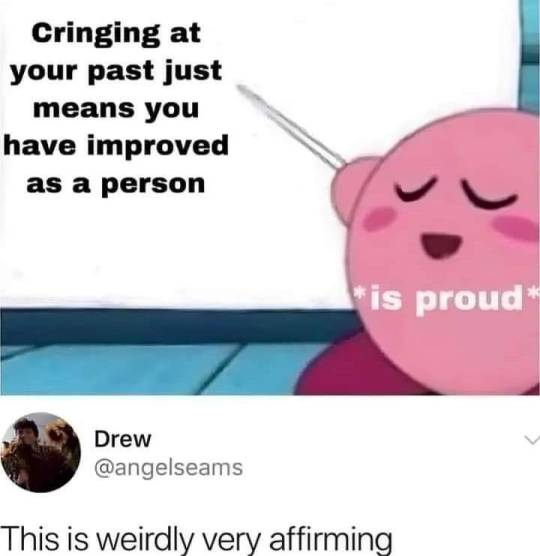#post traumatic growth
Text
That one trend but it’s one increment at a time bc rejection sensitivity dysmorphia has me scared of looking like an idiot with 4 notes ahaha
50 notes & I will
drink more water (easy since I drink like none ever)
regularly post lil hydration reminders
set a new goal
#idek how to tag this#that one trend#if this gets notes#stay hydrated#does this count as body doubling lol#audhd things#autistic things#adhd life#executive dysfunction#autistic self care#self care#adhd autistic#autistic borderline#neurodiversity#undiagnosed chronic illness#self improvement#baby steps#goal setting#audhd creature#dialectical behavior therapy#post traumatic growth#cptsd healing#trauma recovery#autistic system#did osdd
56 notes
·
View notes
Note
“Demons can only be exorcized with love, support, and the will to get better.”
Did you intend for that to be such a powerful line?
-🪶anon
It’s only powerful because it’s the truth. If you want people to get better mentally, then you need all three. It doesn’t matter how strong someone is, if they don’t feel supported, if they’re not given financial, emotional, or personal support, then they will not have the will to get better, they can’t put in the work, and they will not have the healing factors that allow people to come back from a dark place.
Nothing heals better then love, resources, and stability.
So it’s always good to support people in your life. It’s always better to show love to others, even if they’re going through something you can’t understand or relate to. It’s real to them, and that’s all that matters. We live in an age where it’s easy to judge strangers, and yes, there are some things that are unacceptable. But it’s always better to try and understand people, their pain, their concerns, before you jump to making decisions about them.
Trauma is not easy, but those are the only real cures for it.
#rottmnt#save rottmnt#rise of the teenage mutant ninja turtles#tmnt#unpause rottmnt#save rise of the tmnt#rottmnt nightmares comic#mental health#post traumatic growth#recovery#PTSD#ptsd awareness#trauma#healing from trauma
41 notes
·
View notes
Note
Am I asexual or just traumatized--that is the question
*sigh* Ahhh anon…
My heart feels for you. Your question is a serious one. One not to be overlooked.
Preface: This is in no way meant to look down upon or lower the validity of asexuality. I am a fierce part of the lgbtqia+ community, and I 100% support the ace community within ♥️♥️♥️. This discussion relates to trauma and the unfortunate downside of asexuality being used as a coping mechanism.

A lot of people experience trauma… And there are many ways people cope with their trauma. One unfortunate coping mechanism is shutting yourself off completely, because of the trauma, i.e. using asexuality as a coping mechanism.
My recommendation? Work through your trauma. Address it. Get a professional to help, online or in person. Talk through it. Talk with the people you love and trust. Write about it. Draw about it. Sing about it. Get it out. Process it. Heal from it.
Once you have worked through your trauma, then you can see what’s really left. Is it truly asexuality? Or was it actually a trauma deflection mechanism?

So, I’m proud of you for asking that question. Don’t stop there. Look into it. I believe in you. You got this. And let me know how it goes!! 💞💞💞
Talk with Me ❤️🔥
#talk with me#anon asks#you got this#believe in yourself#you can do hard things#hard things#healing from trauma#post traumatic growth#growing from trauma#trauma#traumatic experience#traumatic memories#traumatic childhood#asexual#asexuality#asexuality spectrum#cissyenthusiast010155 answers
20 notes
·
View notes
Text

As long as you are NOT cringing at others still living presently like you just were...
#quotations#beautiful quote#ex jw#healingjourney#exjw#love#quote#ex jehovah's witness#post traumatic growth
15 notes
·
View notes
Text

Everything is cloudy but I will heal and I will rise. Bearing through unbearable pain of hurts that have been done to me.
#love#mental health#trauma#traumahealing#kindness#mentalheathawareness#ptsd#growth#mental heath support#post traumatic growth#healingjourney#healing quotes#self respect#self healing#selflove#self growth#self worth#spread kindness#kind#fairydustandstuff#trysofter#post traumatic stress disorder#self love reminders#self love#strength#strong#softgirlhealing
8 notes
·
View notes
Text

142 notes
·
View notes
Text
Processing trauma is a B I T C H and I despise it, unlearning toxic behaviours and getting to live a better quality life be damned.
Like, you just sit there and feel like shit. And you have to THINK. About your TRAUMA. Which is PAINFUL. So you feel even more like shit until you reach an emotional catharsis. And THEN you have to stop doing the thing caused by that trauma, which is even HARDER because half of the time it's something you've been doing for years.
And THEN you have to process even MORE trauma and that cycle repeats again. Fucking wild.
#post traumatic growth#unlearning#toxic family#dysfunctional family#toxic parents#toxic household#dysfunctional parents#trauma processing in a nutshell#trauma meme#actually traumatized#trauma processing#trauma recovery
57 notes
·
View notes
Text
sometimes i like to pretend that it's summer, and im just waking up. my bed is hot, the fan on my roof is sitting still. a strange stupor of wakefulness washes into my room. the sun is coming up, its yellow just like i remember it. dust swirls through the stream. i have to go get ready for school. sometimes i like to pretend that it was a bad dream, and that im coming back to life. i wipe sleep from my eyes. i am okay, i comfort myself in my childhood bedroom. the memory falls from me, blurring at the edges. distilling away the pictures and leaving a thick residue behind, a feeling of regret. but im okay.
sometimes i like to pretend none of it was real.
#complex ptsd#poetic#poems and poetry#ptsd recovery#ptsd poem#love poem#mental health#sad poem#my poem#prose poem#childhood ptsd#childhood abuse#childhood trauma#cpstd#prose poetry#drunk poetry#poetry#family trauma#post traumatic growth#trauma posting#trauma poem#trauma poetry
9 notes
·
View notes
Text
I learned a new term yesterday. It’s the opposite of PTSD. It’s PTG. The G stands for growth.
POST TRAMAUTIC GROWTH
I learned the basis of this theory, resilience, is an engineering term that means: "the capacity of a system to endure and recover from disruptions while still functioning effectively."
OVERCOMING OBSTACLES.
But then there is a second level of resilience in engineering referred to as adaptive resilience. It "emphasizes the system's ability to learn, evolve, and improve in response to disruptions or changing circumstances."
GROWING BECAUSE OF OBSTACLES.
The science behind the old saying "When life gives you lemons, make lemonade."
I love science.
Instead of letting trauma or setbacks destroy us or just simply recovering, we all have the ability to grow from these experiences if we let ourselves.
I will continue to grow from all the garbage. The disloyalty and betrayal and disappointments and setbacks.
I’m going to grow so much I will not be containable. I will grow right past the people who make me feel bad.
I think they will look back and they will miss me and wish they had treated me better.
2 notes
·
View notes
Text
Introduction to the Theory of Post-Traumatic Growth
The concept of Post-Traumatic Growth (PTG) describes the potential for positive psychological change experienced as a result of the struggle with challenging life circumstances and trauma (Tedeschi & Calhoun, 2004). Research has identified several domains in which individuals may experience growth: appreciation of life, relationships with others, new possibilities for oneself, personal strength, and spiritual development (Tedeschi, Park, & Calhoun, 1998).
Exploring Post-Traumatic Growth
In this exploration, we delve into the intricate journey of Post-Traumatic Growth (PTG), a path that individuals may tread following the upheaval of a traumatic experience. PTG represents more than just recovery; it implies a transformative process leading to personal development that surpasses pre-trauma levels of adaptation and functioning. To capture the nuance of this transformative journey, we consider a set of equations that reflect the multifaceted nature of growth within the context of trauma.
Understanding the Dimensions of PTG
Understanding the Dimensions of PTG = Appreciation of Life + Relationships with Others × New Possibilities ÷ Personal Strength − Spiritual Change
In the quest to understand the dimensions of PTG, we look at how a renewed sense of life's value, the power of social bonds, the discovery of new paths, the role of innate resilience, and the shifts in spiritual outlook weave together to form a tapestry of growth.
Appreciation of Life stands at the forefront of PTG, encapsulating the profound reverence for existence that often emerges from the ashes of trauma. It is the foundation upon which other aspects of growth are built, highlighting the transformative power of surviving adversity.
Relationships with Others intertwine with this newfound appreciation, amplifying its effect. The social fabric becomes a lattice for support and connection, reinforcing the individual’s ability to find meaning and solace after a traumatic event.
New Possibilities emerge as individuals reassess their life's trajectory in the wake of trauma, often finding new directions and aspirations that were previously unconsidered. This discovery is significantly influenced by the strength and depth of one’s relationships.
Personal Strength is the inherent resilience that a person draws upon in the face of challenges, which serves to integrate and leverage new opportunities for growth that arise from the trauma.
Spiritual Change often accompanies the PTG journey, as individuals re-examine and sometimes redefine their spiritual beliefs and values in the aftermath of trauma. This introspection can lead to profound personal shifts in the way one views their existence and purpose.
Processes Leading to PTG
Processes Leading to PTG = Cognitive Processing × Emotional Regulation + Disclosing and Narrating the Trauma − Existential Reevaluation ÷ Support from Others
The processes leading to PTG involve the intricate dance between cognitive and emotional realms, the sharing of one’s story, the reevaluation of one’s life purpose, and the crucial role of support from others.
Cognitive Processing is the mental engagement with the trauma, where one actively contemplates and makes sense of the event and its repercussions. It is a critical step in framing the trauma within the context of one's life narrative.
Emotional Regulation reflects the ability to navigate and manage the intense emotions that accompany traumatic experiences. This skill is pivotal in allowing cognitive processing to unfold in a constructive manner.
Disclosing and Narrating the Trauma is the act of sharing one’s traumatic experience, either verbally or through other forms of expression. This disclosure is integral to the healing process, providing a release and often contributing to a sense of coherence and understanding.
Existential Reevaluation is the deep questioning of life's meaning that trauma can provoke. This reflective process can lead to significant alterations in one’s worldview and sense of self.
Support from Others is the communal backing that provides a buffer during the existential questioning, offering a sense of security and perspective that aids in the navigation of this reevaluation.
Facilitation of PTG
Facilitation of PTG = Creating a Safe Space ÷ Validation + Encouraging Deliberate Rumination × Exploring Changes − Identifying Strengths + Goal Setting − Developing Compassion ÷ Spiritual Exploration + Continuous Support
The facilitation of PTG is achieved through a nurturing environment, reflective practices, goal-oriented behaviors, compassion development, spiritual inquiry, and ongoing support, all contributing to the scaffolding necessary for growth post-trauma.
Creating a Safe Space is the foundational requirement for PTG, where individuals feel secure to explore their feelings and thoughts without judgment or fear.
Validation is the acknowledgment and acceptance of an individual's experiences and emotions, which is essential for creating the trust and safety needed for growth.
Encouraging Deliberate Rumination involves thoughtful reflection on the traumatic event and its impacts, fostering a deeper understanding and integration of the experience.
Exploring Changes signifies the active examination of how one has transformed post-trauma, which can lead to a redefined sense of self and purpose.
Identifying Strengths is the recognition of one's abilities and qualities that have been either bolstered or uncovered through the process of facing and overcoming trauma.
Goal Setting is the forward-looking activity that orients individuals towards the future, providing direction and motivation as they rebuild their lives.
Developing Compassion is both a personal and interpersonal gain, as individuals learn to extend kindness to themselves and others, which can enhance relationships and personal well-being.
Spiritual Exploration is an inward journey that can be facilitated by creating space for spiritual questioning and development, often serving as a substrate for growth and understanding.
Continuous Support underscores the importance of ongoing assistance and care from others, whichcan serve as a constant source of strength and reassurance throughout the journey of post-traumatic growth. This continuous support helps maintain momentum in the growth process and provides a safety net during challenging times. It is through the interplay of these factors—safe spaces, validation, deliberate rumination, exploration of changes, identification of strengths, goal setting, developing compassion, spiritual exploration, and continuous support—that individuals find the fertile ground in which the seeds of post-traumatic growth can take root and flourish. Each element plays a critical role in nurturing the transformative process that enables individuals to emerge from trauma not just recovered, but profoundly changed in positive ways.
Recognizing the boundaries and challenges of PTG reminds us that it is not a universal experience, does not follow a straight path, is not a magical cure, must be culturally sensitive, and sometimes requires the guidance of professionals
Understood. I will provide a revised introduction and conclusion to the theory of Post-Traumatic Growth (PTG), using actual peer-reviewed references up to my knowledge cutoff in April 2023. Please note that actual peer-reviewed references will not include made-up articles or authors.
The facilitation of PTG is believed to be contingent upon both individual and environmental factors, including supportive social networks and adaptive coping strategies (Linley & Joseph, 2004). Interventions aimed at fostering PTG often emphasize therapeutic techniques that help individuals process their trauma and reconstruct their perceptions of themselves and the world (Joseph, Williams, & Yule, 1993).
Considerations and Cautions
Considerations and Cautions = universal - linear + Not a Panacea ÷ Cultural Sensitivity × Professional Support
This formula speaks to the nuanced understanding required when considering the concept of Post-Traumatic Growth (PTG) and its application across different individuals and contexts.
The concept of Post-Traumatic Growth (PTG) is a complex and multifaceted one that cannot be considered universally applicable to all individuals who experience trauma. It is not a linear process, meaning that the path to PTG does not follow a straightforward or predictable sequence of stages (Tedeschi & Calhoun, 2004). Recognizing PTG as a potential outcome should not lead to the assumption that it is a panacea, or a cure-all for the adverse effects of trauma. Indeed, not every individual will experience growth following trauma, and for some, the idea of finding any positive outcome in their suffering might seem implausible or even offensive.
Furthermore, considering PTG requires a high degree of cultural sensitivity. The interpretation of trauma, as well as the expression and acknowledgment of growth thereafter, is deeply influenced by cultural beliefs and practices (Tedeschi, Shakespeare-Finch, Taku, & Calhoun, 2018). What constitutes growth in one culture may not be recognized as such in another. Thus, acknowledging the cultural context is paramount when evaluating the presence or possibility of PTG.
Lastly, professional support can be a critical factor in facilitating or recognizing the process of PTG. Mental health professionals trained to recognize the signs of PTG can offer interventions that support the individual's journey through trauma recovery. Such support should be sensitive to the individual's unique experience and cultural background, and professionals should be cautious not to impose their own narratives of growth on their clients (Calhoun & Tedeschi, 2006).
Conclusion to the Theory of Post-Traumatic Growth
In sum, PTG represents a robust area of psychological research that underscores the human capacity for resilience and positive change following adversity. While PTG does not minimize the pain and suffering caused by traumatic events, it highlights the potential for individuals to emerge from these experiences with a newfound sense of personal strength and purpose (Calhoun & Tedeschi, 2006). Continuing research aims to elucidate the mechanisms of PTG and optimize support strategies that may facilitate this growth process (Zoellner & Maercker, 2006). Ensuring that individuals have access to appropriate resources and support following trauma is crucial to promote positive psychological outcomes and PTG.
References:
Calhoun, L. G., & Tedeschi, R. G. (2006). Handbook of posttraumatic growth: Research and practice. Lawrence Erlbaum Associates Publishers.
Joseph, S., Williams, R., & Yule, W. (1993). Changes in outlook following disaster: The preliminary development of a measure to assess positive and negative responses. Journal of Traumatic Stress, 6(3), 271-279.
Linley, P. A., & Joseph, S. (2004). Positive change following trauma and adversity: A review. Journal of Traumatic Stress, 17(1), 11-21.
Tedeschi, R. G., & Calhoun, L. G. (2004). Posttraumatic growth: Conceptual foundations and empirical evidence. Psychological Inquiry, 15(1), 1-18.
Tedeschi, R. G., Park, C. L., & Calhoun, L. G. (1998). Posttraumatic growth: Positive changes in the aftermath of crisis. Lawrence Erlbaum Associates Publishers.
Zoellner, T., & Maercker, A. (2006). Posttraumatic growth in clinical psychology — A critical review and introduction of a two-component model. Clinical Psychology Review, 26(5), 626-653.

3 notes
·
View notes
Text
I wish I was brave enough to kill myself
#i’m done#tw suicice#mentally tired#actually mentally ill#boderline personality disorder#anxitey#stress#post traumatic growth#ptsd#fuck this#i’m angry#i’m sad#it huuuuuuuurts#let me die#can’t be saved#rock bottom#im hurtin#I’m so low#i am a coward#kill my brain#kill my thoughts#kill me#sadnees#hurtful#who am i#disasociation
9 notes
·
View notes
Text
I hope you heal so much that taking care of yourself is one of your favorite things to do and I hope you can forgive yourself for everything you did before you got there
#trauma recovery#complex trauma#ed recovery#ana recovery#csa survivor#cptsd healing#cptsd vent#trauma disorders#traumagenic#adverse childhood experiences#childhood trauma#medical trauma#autistic trauma#neurodiversity#did osdd#complex post traumatic stress disorder#post traumatic growth#self care#trauma healing#trauma brain#childhood neglect#childhood abuse#substance abuse#abuse recovery#late diagnosed autistic#childhood emotional neglect#bpd thoughts#autistic borderline#borderline personality disorder#adhd autistic
58 notes
·
View notes
Text
Post, Trauma
I read a fic today, and it mixed what happened (is happening) it's all together.
I read a fic today, and it hurts me. And it made me think. It haunt me as I try to sleep
They call it Post Trauma, and it makes me want to cry, and laugh, and punch the wall uncontrollably.
They call it POST trauma, yet it's the exact opposite - the problem here is that it isn't, it won't- it can't be- gone.
They call it post Trauma, and - maybe it's right, in a different way.
As if it's written all over your body, a message sent to your future self -
You made it through
(You survived).
#fic#my writing#post traumatic stress disorder#post traumatic growth#post trauma#hurt#pain#trauma#words#my poem
7 notes
·
View notes
Text
IMPORTANT:
This is a proshipper blog. I use shipping (and sometimes headcanons) as a way of coping with my trauma. This may result in me posting some problematic, uncomfortable, or undesirable content. I WILL put TW's on my posts, but I wanted to make it clear that my content may be triggering or uncomfortable for some people.
#proship#proshippers please interact#proshipper safe#proshippers are valid#tw proship#tw trauma#antis dni#problematic ships#problematic#uncomfortable#trauma#post traumatic growth#coping mechanism#coping methods#trauma coping
5 notes
·
View notes
Text

#reactive abuse#abusiveboyfriend#abuse#abusive husband#abusive partner#abusive spouse#abusive relationship#abusive marriage#healingjourney#beautiful quote#self love#personal growth#post traumatic growth#quote#love
12 notes
·
View notes
Text
me, to me: damn, maybe my trauma wasn't so bad, maybe I was taking things the wrong way and really did make a monster out of my mother
my traumatized brain:

#trauma survivor#trauma recovery#trauma#post traumatic growth#post traumatic stress disorder#complex post traumatic stress disorder#complex ptsd#trauma test#scapegoat child#childhood abuse#child abuse#childhood emotional neglect#tw child abuse
44 notes
·
View notes